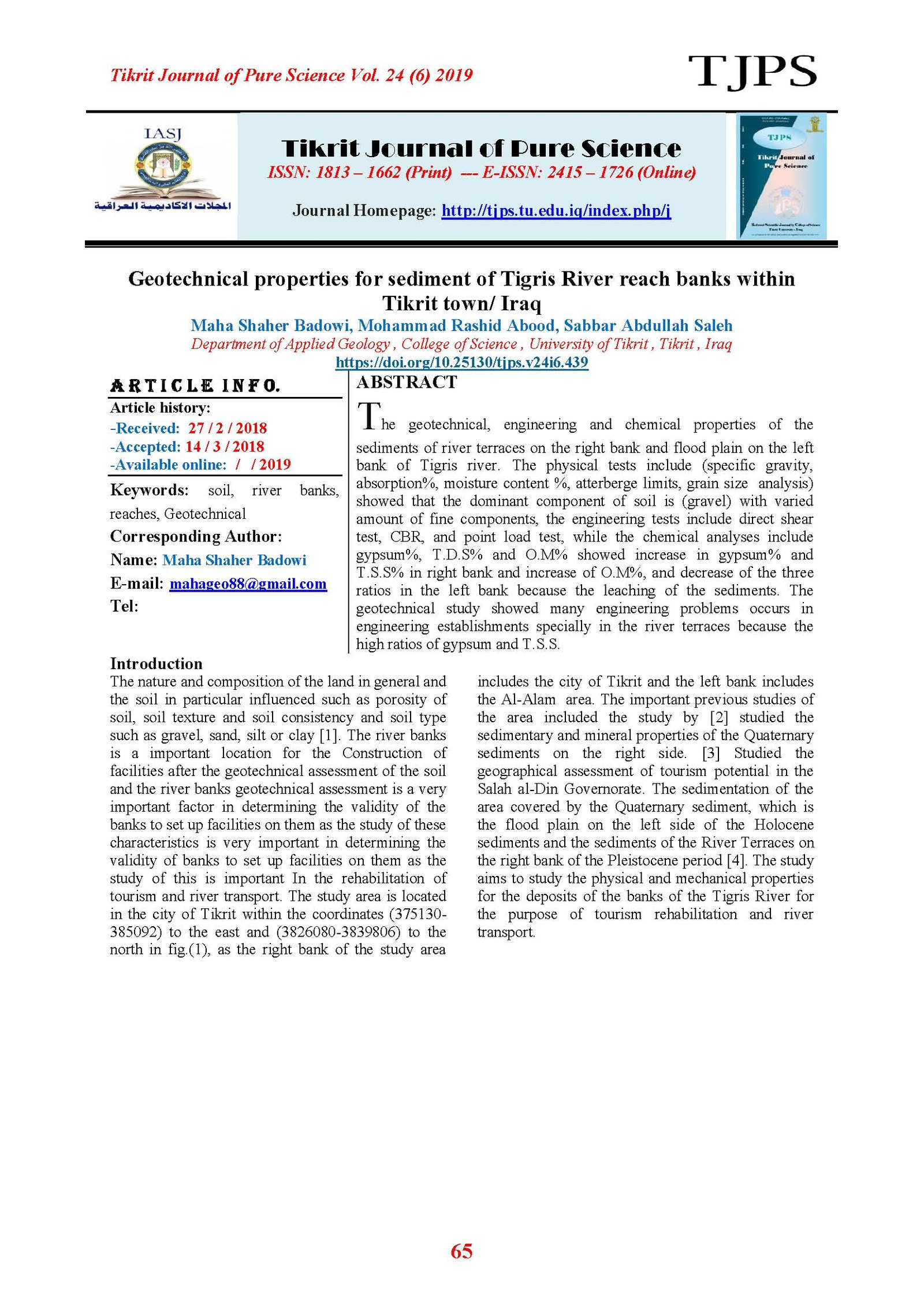Geotechnical properties for sediment of Tigris River reach banks within Tikrit town/ Iraq
Main Article Content
Abstract
The geotechnical, engineering and chemical properties of the sediments of river terraces on the right bank and flood plain on the left bank of Tigris river. The physical tests include (specific gravity, absorption%, moisture content %, atterberge limits, grain size analysis) showed that the dominant component of soil is (gravel) with varied amount of fine components, the engineering tests include direct shear test, CBR, and point load test, while the chemical analyses include gypsum%, T.D.S% and O.M% showed increase in gypsum% and T.S.S% in right bank and increase of O.M%, and decrease of the three ratios in the left bank because the leaching of the sediments. The geotechnical study showed many engineering problems occurs in engineering establishments specially in the river terraces because the high ratios of gypsum and T.S.S.
Article Details

This work is licensed under a Creative Commons Attribution 4.0 International License.
Tikrit Journal of Pure Science is licensed under the Creative Commons Attribution 4.0 International License, which allows users to copy, create extracts, abstracts, and new works from the article, alter and revise the article, and make commercial use of the article (including reuse and/or resale of the article by commercial entities), provided the user gives appropriate credit (with a link to the formal publication through the relevant DOI), provides a link to the license, indicates if changes were made, and the licensor is not represented as endorsing the use made of the work. The authors hold the copyright for their published work on the Tikrit J. Pure Sci. website, while Tikrit J. Pure Sci. is responsible for appreciate citation of their work, which is released under CC-BY-4.0, enabling the unrestricted use, distribution, and reproduction of an article in any medium, provided that the original work is properly cited.
References
[1 Al-Humeiri, Muwafaq Adnan and Nabil Za'al Al Hawamdeh, Tourism Geography in the 21st Century a methodology process and analysis of a new ideological view and a modern methodology, Jordan, Dar Al-Hamed for Publishing and Distribution,2006.
[2] Kadhim, L.S. and M.W. Ajeel, Sedimentological and mineralogical studies of Quaternary sediments in Tikrit area, University of Tikrit, 1st scientific conference, college of Science, 2009.
[3] AL- Aswadi, M. R. R. Abdullah, Geographical Evaluation for tourist capacities in Salahalddin Governorate, Master Thesis, Tikrit University, 2013.
[4] Jassim, S.Z. and J.C. Goff, Geology of Iraq, Dolin, Prague and Moravian Museum Brno, 2006.
[5] ASTM D2216-10, Standard Test Methods for Laboratory Determination of Water (Moisture) Content of Soil and Rock by Mass1, 2007.
[6]-ASTM C127-15, Standard Test Method for Relative Density (Specific Gravity) and Absorption of Coarse Aggregate1, American Society for Testing Materials, West Conshohocken, Pennsylvania, 2007.
[7] ASTM D422-63 (Reapproved 2007)ᵋ2, Standard Test Method for Particle-Size Analysis of Soils1, American Society for Testing Materials, West Conshohocken, Pennsylvania, 2004.
[8] ASTM, D 854-02, Standard Test Methods for Specific Gravity of Soil Solids by Water Pycnometer, 2004.
[9] ASTM D4318-10, Standard Test Methods for Liquid Limit, Plastic Limit, and Plasticity Index of Soils1, 2007.
[10] ASTM, D1557-02E, Standard Test Methods for Laboratory Compaction Characteristics of Soil Using Modified Effort (56,000 ft-lbf/ft3 (2,700 kN-m/m3)) 1, 2004.
[11] ASTM, D1883, Standard Test Method for Determination California Bearing Ratio for Aggregate, 2005.
[12] ISRM, Suggested method for determining point load strength. ISRM Commission on Testing Methods, Working Group on Revision of the Point Load Test Method. Int. J. Rock Mech. Min. Sci. & Geomech. Abstr., Vol.22, 1985, pp.51-60.
[13] ASTM, D 3080-03, Standard Test Method for Direct Shear Test of Soils Under Consolidated Drained Conditions, 2004.
[14] Hand Book N0.60, diagnosis and Improvement of saliue and Alkali soils, Agric., US Department of Agriculture (USDA), Washington D.C.,1959.
[15] Das, B.M., Principles of geotechnical engineering 7th ed., USA, Cengage learning, 2010.
[16] Anon., The description of rock masses for engineering purposes, Report by the Geological Society Engineering Group Working Party, Quarterly Journal of Engineering Geology, Vol. 10, 1977, pp. 355-388.
